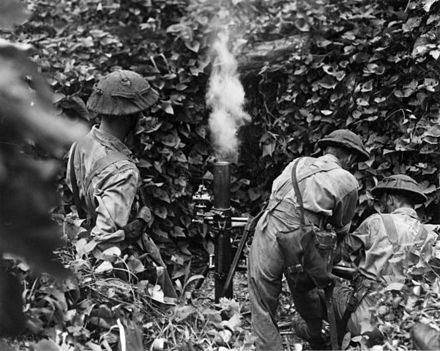
A New Zealand mortar squad on Mono Island during the Battle of Treasury Islands. For more details about the Battle of Treasury Islands, click this link.
By: Phil Kohn. Dedicated to the memory of his father, GM3 Walter Kohn, U.S. Navy Armed Guard, USNR, and all men and women who have answered the country’s call in time of need. Phil can be contacted at ww2remembered@yahoo.com.
On October 15, 1943, German troops surround Rome’s Jewish quarter. A second day’s bombing of Kassel, Germany, by the RAF takes place on October 22, 1943. The 416,000 incendiaries dropped by 569 bombers cause a firestorm that keeps flames burning for seven days in the city of 236,000. Over 10,000 people — mostly civilians — are killed and 150,000 are rendered homeless.
A German torpedo-boat flotilla on October 23 sinks the Royal Navy cruiser HMS Charybdis and the destroyer HMS Limborne in an attack in the English Channel. From Japanese-occupied Singapore, the provisional government of Azad Hind (“Free India”) declares war on the United Kingdom and the United States. In Italy, almost 1.5 million people begin evacuating Naples in fear of a rumored bombing threat that, in fact, never materializes. The Soviet 28th Army — after many days of heavy street fighting — drives the German Sixth Army out of Melitopol, in southeastern Ukraine.
In the Bismarck Archipelago, Allied aircraft on October 24 raid Rabaul, New Britain Island, for a second time in two days. One Japanese destroyer and five merchant ships are sunk in the raids. At Aitape, Papua-New Guinea, captured Australian commando Sgt. Leonard Siffleet is executed by beheading. A photograph taken just a moment prior to Siffleet’s execution by a sword-wielding Japanese soldier is found six months later by American soldiers on the body of a dead Japanese officer at Hollandia, Papua-New Guinea. The photo — believed to be the only picture of the execution of a POW by a Japanese soldier — is published in Australian newspapers and in LIFE magazine in the U.S.
On October 25, the Japanese open the infamous 258-mile-long Burma-Siam Railway, connecting Bangkok, Thailand, with Rangoon, Burma. The Japanese used 61,000 British and Commonwealth POWs and some 220,000 Burmese forced laborers to build the railroad. Over 90,000 Burmese and 12,000 prisoners died during construction. (The building of the railroad was the setting for Pierre Boulle’s novel [and a subsequent motion picture], The Bridge over the River Kwai.) In Europe, the Red Army’s 3rd Ukrainian Front captures Dnipropetrovsk, Ukraine’s fourth-largest city.
An amphibious invasion of the Treasury Islands, south of Bougainville in the Solomons, is made on October 26 by the New Zealand 8th Brigade, which defeats the Japanese garrison stationed there. Following the islands’ capture, U.S. Navy Seabees build an airstrip used for attacks on the Japanese base at Rabaul. In Germany, a prototype of the Dornier Do 335 heavy fighter makes its first flight. The plane will be the Luftwaffe’s fastest piston-engined aircraft during the war.
The first prototype stainless-steel airplane — the twin-engined RB-1 Conestoga cargo plane, designed for the U.S. Navy by Philadelphia’s Budd Company — rolls off the assembly line on October 27. The craft never becomes operational, however, due to steel-price increases, production problems and excessive fuel consumption.
In the U.S., unresolved disputes have caused coal miners to once again start walking off their jobs. By October 28, thousands are on strike and the work stoppage is gaining momentum. In the Pacific, 650 U.S. Marines of the 2nd Parachute Battalion led by Lt. Col. Victor “Brute” Krulak, land on Choiseul, in the Solomon Islands. Their mission is to conduct raids against Japanese army and navy facilities on the island to divert attention from planned Allied landings on Bougainville at Empress Augusta Bay.



